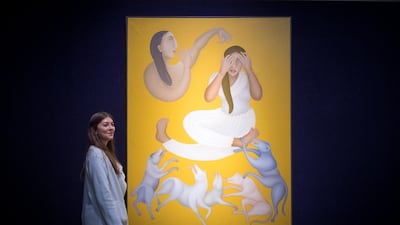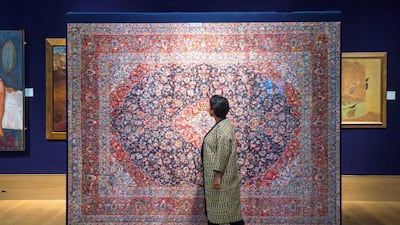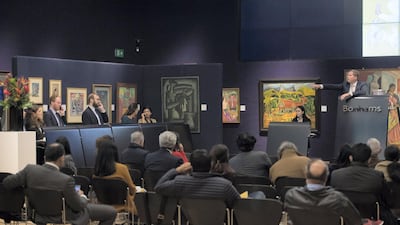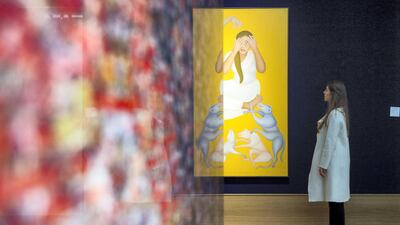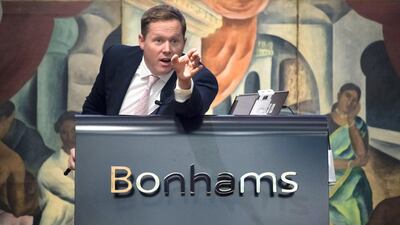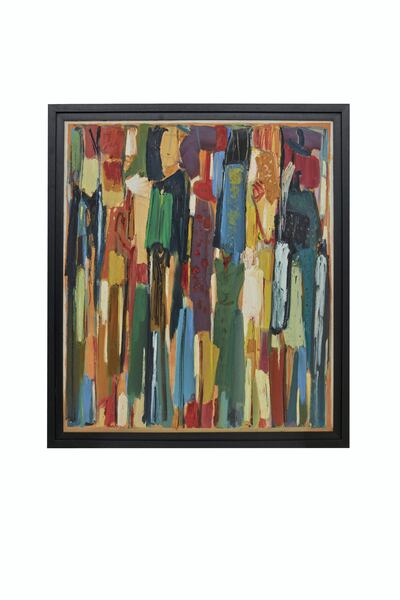When the Abraaj Group announced it was selling off part of its significant collection of Middle Eastern and South Asian art, and that its chairman, Arif Naqvi, appeared to be offloading works from his collection, the news wasn’t just about the attempt to raise cash – it was also about the massive price drops the artworks had suffered.
Many of the works that the Abraaj Group and Naqvi put up for sale with Bonhams and Christie's in London had been acquired in 2008, at the top of the market for Arab and Iranian art. A painting that sold for a cool $1 million (Dh3.67 million) – hammer price, meaning without fees and commission – was given a low estimate at Bonhams of $66,000, or GBP 50,000. Other works came with estimates that were quarters or thirds of the prices initially paid. The differential seemed to confirm what Arab art market watchers have long suspected: the Arab art market is a bubble that is bursting, with prices untethered from an artist’s real stature in art history, and the added problem of looted work and fakes after a half-century of unrest in the Middle East.
Looking at each work's price, what can we learn?
Firstly, Bonham priced the works cannily: they gave low estimates, hoping bidding would drive the final sales up. This strategy mostly paid off. Paul Guiragossian's Celebrations, one of the stand-out lots of the sale, was given a low estimate of £40,000, and sold for £175,000 (Dh1,041,000). Mohammed Ehsai's calligraphic He Is Merciful was given a low estimate of £50,000 and went for £321,000 (Dh1,909,000). Two mid-century paintings by the Syrian artist Fateh Moudarres were each given low estimates of £7,000 and achieved £20,000 each (Dh119,000). Not all of the works fared so well. A pair of sculptures by the Iranian artist Parviz Tanavoli landed within their £18,000 to £25,000 estimates, though his larger Poet and the Bird surpassed its low estimate of £50,000 to fetch £237,000 (Dh1,409,000).
The estimates were higher at Christie's, and many of the works there failed to exceed expectations. Louay Kayyali's painting The Ice Cream Seller went for £62,500, hitting below its high estimate of £70,000. Fateh Moudarres's two-metre-wide The Last Supper eked above its high estimate of £120,000 to realise £122,500. Others did better: Chafic Abboud's beautiful abstraction, Les Bons Sentiments, rose from its £30,000 low estimate to achieve £75,000.
But the picture's not so rosy when compared with what these works originally brought in. Ehsai's He Is Merciful, which went for more than four times above estimate, was the work that originally went for $1 million (£775,000). That is, its price today is still less than a quarter of what Abraaj paid in 2008. Likewise, Tanavoli's Poet and the Bird, though bringing in £237,000, went for £310,000 ten years ago. Charles Zenderoudi's painting Purple Pearl went for £210,000 in 2008 and went for £75,000 today. Kayyali's Ice Cream Seller has stayed pretty much the same: it went for £62,000 in 2010 (so sold for only £500 more this week).
The broad conclusions are clear: Iranian work has dropped heavily, 2008 was inflated across the board, and the works that did well are from those artists whose critical reputations have risen since.
Shedding light on the work of important artists
These figures only tell part of the story. When gleefully reassessing the frenzy of 2008, it is helpful to put things in perspective: any art market will have winners and losers, and the curatorial and academic interest that rose in tandem with these artists' prices at auction has affected their work's prices since. Guiragossian's joyful Celebrations, on sale at Bonhams for example, slightly increased in value; it sold for £140,000 in 2008, and achieved £175,000 this week. This is so despite the fact that many similar Guiragossian paintings have come to auction – a consistent supply that is balanced by the critical attention Guiragossian's work has achieved since 2008.
The late Armenian-Lebanese artist had a major solo show in 2013 at the Beirut Exhibition Centre curated by Sam Bardaouil and Till Fellrath, and, together with the artist's daughter, Manuela Guiragossian, the pair this year published the first monograph of his paintings. A smaller retrospective also went on view this year at the Barjeel Art Foundation in Sharjah curated by Sheikha Maisa Al Qassimi.
For the talks programme of Abu Dhabi Art next month, two major scholars of Arab modernism, Nada Shabout and Salwa Mikdadi, have chosen to investigate the market for Arab modern works. The topic is more surprising than it might seem. Rarely (if ever) do talks programmes, which regularly accompany art fairs, address the 'what brought them there?': aka, the market itself. And secondly, there is a feeling that the historiography of Arab modernism cannot be written without including the market’s role in driving interest in these artists.
More than reading the tea leaves at Bonhams, those who want to understand the Arab art market might make their way to the auditorium of Abu Dhabi Art, where there will be presentations and panel discussions but nary a hammer in sight.
_____________
Read more
The hunt is on for modern Middle East art
Fire sale of Abraaj art at auction: Million dollar work on the block starting at $66,000
Abraaj art fire sale raises Dh21.3 million at London auctions
